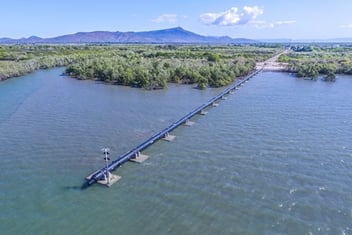Keep up with contaminants of emerging concern
Welcome to the challenging world of water quality and management: navigating contaminants of emerging concern (CEC).
By their very definition, CECs do not have existing guidelines relating to their management. Given their potential for considerable adverse impacts, the need to have a comprehensive and reliable database about the thousands of chemicals that qualify as CECs is significant.
Identifying and building a framework and collating this information in order to determine which CECs are prioritised is an essential step in safeguarding both community and environmental health.
Dr Steven Melvin, Research Fellow at the Australian Rivers Institute, Griffith University, and his colleagues have spent the past year doing just that: using a three-part process to build such a framework.
Melvin will go into the details of this Water Research Australia-funded project on Day 1 of Ozwater’21 in his session "Developing a risk assessment and management framework for the prioritisation of contaminants of emerging concern (CEC)".
Put a name to it
The first step was to identify and determine a list of CECs as complete as possible.
“We just looked as far and wide as we could,” said Melvin, citing some of the sources included.
“We looked at national [government] documents; international documents — for example those from the European Chemicals Agency, the REACH program, the Norman Network of Emerging Substances, and the US EPA Contaminant Candidate List.”
To ensure the outcome of this framework would also be relevant to the industry more broadly, chemicals included in industry sources, such as the Seqwater DATATOX database, were also included. To round out these perspectives, authoritative academic sources of CECs were also consulted.
“That gave us a big, big list of 1719 CECs,” said Melvin. “That’s a huge number of chemicals.”
Although this first step of identifying a longlist of chemicals was significant in and of itself, it didn’t necessarily offer any guidance on risk or prioritisation.
Determine a shortlist
Shortlisting was therefore essential.
“The next step was essentially to [identify a] shortlist — to go through those chemicals and try to prioritise which ones we proceed with,” Melvin said.
To do this, a framework using the characteristics of toxicity was put in place and each of the 1719 CECs was analysed according to how it measured up on factors of persistence, bioaccumulation, and toxicity (PBT). Mutagenicity and estrogenicity were also considered, since they are not always captured by the PBT framework.
“If something’s all three of those — if it’s persistent, if it’s really bioaccumulative and if it’s toxic — it’s probably a pretty big problem,” explained Melvin.
“Essentially, we extracted information for all of the chemicals [and] we used that to classify our shortlist into different priority groups.”
Against a background of bushfires, and the commonality of flame retardants in everyday life, flame retardants emerged as one of the highest priority chemical categories.
Prioritise according to risk
In this final stage, risk quotients were calculated for all CECs shortlisted.
“In order to do that for all of these remaining chemicals, we did a comprehensive literature review,” explained Melvin of the process.
Information on “source, effect [toxicity] and removal through known sewage or drinking water treatment processes” was also sought to better understand the high risk CECs.
And while effectively managing CECs continues to pose significant challenges — compounded by the lack of information inherent to CECs — the research team has been able to fill in some of those data gaps through pre-existing models and fugacity modelling.
“[We did this to] get the most comprehensive database we could work with for risk prioritisation.”
This approach has culminated with all information on these CECs compiled into a huge database, termed ECHIDNA (the Emerging Chemicals Database for National Awareness), that will be kept up-to-date going forward so that those in the water industry — whether professional, academic or otherwise —— have an accessible, reliable source of information on CECs.
Hear more from Dr Steven Melvin on Day 1 of Ozwater’21 in his presentation "Developing a risk assessment and management framework for the prioritisation of contaminants of emerging concern (CEC)" and get an early look at the database that aims to help the industry manage CECs. The event is the largest water conference in the Southern Hemisphere and will be held in Adelaide, 4-6 May 2021. Click here to register.


